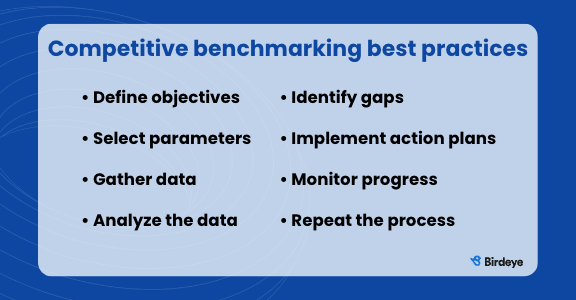To measure anything is to compare it to something else. When you’re in business, there are few better ways to compare your progress than by measuring it against your competitors. Taking a hard and closer look at how you stack up to your competitors will help your company improve and grow.
In this article, we’ll tell you how to use competitive benchmarking to improve nearly every aspect of your business.
Table of contents
What is competitive benchmarking?
Benchmarking is critiquing your performance against a standard. In business, that standard can be your past performance, industry norms, or your competitors. Competitive benchmarking compares your performance — you’ve guessed it — against your competitors. The data you collect about your competitors become the metrics with which you set goals for your company.
You can use competitive benchmarking to improve internal processes, like supplier sourcing or employee recruitment by measuring it against other companies to see how you can do better. Or measuring external metrics, like social media followers or customer review ratings, can help you gauge how your results stack up alongside others.
Competitive benchmarking works best when you earmark top companies for comparison. By setting your sights on first-rate examples, you’ll stretch your own goals for achievement. Maybe you see a competitor running a first-rate marketing campaign that places them top of mind among customers. You can use competitive benchmarking to compare their market research strategy to your own.
Competitive benchmarking versus competitive analysis
You can use competitive analysis and competitive benchmarking together to create a killer business plan. But first, you need to better understand how the two differ.
Competitive analysis is the tool you use to make your business and offering stand out among the competition. With it, you identify your competitors and suss out their strengths and weaknesses. You can then develop a strategy that makes your products or services distinct and special.
Competitive benchmarking, on the other hand, is all about emulating the best practices of your competitors. If you see your competitors winning at social media marketing or manufacturing efficiency, you can borrow their methods to improve your business.
Best practices for competitive benchmarking

The following best practices will help you get the most from your benchmarking efforts. Competitive benchmarking is an ongoing process. So, you can expand your goals, data collection, and action plans once you have the basics down.
Define your objectives
As a business owner, you’re no stranger to setting goals. So it’ll come as no big surprise that the first step to competitive benchmarking is laying out clear objectives. Knowing exactly what you want to improve within your core business model will help you determine what data to collect about your competitors.
Perhaps your churn rate is higher than the other guy’s. Decreasing the churn rate becomes your objective. Now, you can go about collecting data about your competitor that may influence their low churn rate.
Select the benchmarking parameters
With your goals in hand, you’re ready to set your benchmarking parameters. These are the factors you want to measure to help you achieve your goals. Your parameters should be relevant to your business and your industry, and they should be easily comparable to your internal metrics.
Take the churn example from above. Ask yourself what the other company is doing differently that might affect churn. Examine their customer service options, product quality, and incentive programs, along with any other factor that influences that specific metric.
Gather data
Knowing what you want (and probably need) to measure is one thing. Actually, finding the data can be tricky. Your team may need to do a bit of digging to discover the information you need for competitive benchmarking. Benchmarking software, however, can give you a leg up by compiling a competitor’s online information from review sites, forums, blogs, and other channels.
You probably think of reviews sites, forums, and social media first when it comes to keeping tabs on your competitors. But everything from financial reports to trade publications may have nuggets of worthy information. Even reviews from employees on Glassdoor can offer insight into your competitor’s internal workings.
Even with a wealth of online data, your team may need to get creative. Xerox actually purchased a competitor’s copier, disassembled it, and investigated sources for its components. Their aim was to precisely find out how the competition could sell their machines at such a low price. When it comes to gathering data for competitive benchmarking, it pays to think outside the box.
Analyze the data
Once you’ve plucked the internet for mentions of your competitor, you’ll realize it can be difficult to make sense of all that data. You’ll need to develop a way to analyze the information to understand trends and see patterns. With that analysis, you’ll be able to see things like what’s driving customers when they make their purchases or how your company’s brand awareness stacks up against the rest.
Benchmarking software can perform your data analysis for you. You can have a comprehensive view of where your company rates within your industry using your predetermined parameters. Additionally, you can drill down to see the specific reviews or mentions that are driving results. If you see that a competitor consistently has better reviews, you can click to find what, specifically, customers are raving about.
Identify gaps and opportunities
Using competitive benchmarking is all about acknowledging you can do better and then using real data to see what, exactly, you’ll need to do.
For example, if you’re a restaurant chain, perhaps you’ve been focusing on sourcing local ingredients. With benchmarking software, you may discover that customers mention larger portions at lower prices as their main reason for loving your competitor. You can use that information to increase the perception of the value of your own dishes.
Develop and implement action plans
The whole reason to implement a benchmarking system in the first place is to know what you need to do to be the best. Once you’ve analyzed the data and identified your areas for improvement, it’s time to make an action plan. Your goal isn’t to copy your competitor’s methods. Rather, your plan of action makes the most of your strengths to achieve results that outshine the competition.
Let’s go back to our previous example. Say you’re a restaurant chain boasting fresh, local ingredients. But your benchmarking analysis reveals that customers prioritize value over ingredients. Instead of switching to the same over-processed but inexpensive food your competitor offers, try something different. Look for ways to reduce overhead costs, offer frequent customer discounts, or more attractive daily specials, without sacrificing what makes you special.
Monitor progress
Your action plan should include key performance indicators (KPIs) and a timeframe in which you expect to achieve it. Then, use your benchmarking software to continuously monitor your progress toward your goal. You may also find a need to make changes to the plan to achieve your goal. For example, you may need to boost your market research efforts or create incentives to persuade customers to try your business again.
Repeat the process
Competitive benchmarking really is one of the best ways to become a top-rated company. And that’s why your competitors use it as well. That means you need to make competitive benchmark analysis a continuous practice for your company. Because once you surpass the competition, you’ll become the benchmark.
Competitive benchmarking benefits

When practiced over time, competitive benchmarking is a boon for your business. Just as important, it provides a yardstick you can use to measure your progress. And you’ll reap the following benefits from it.
Identify areas for improvement
It’s often difficult to see our own shortcomings. That’s why looking at others can provide perspective. In business, competitive benchmarking creates a frame of reference so that we can see opportunities for improvement.
Gain insights into industry trends
In a constantly-evolving business market, seeing the big picture can be tough. Market changes, customer preferences, and competitor strategies all affect your growth. Yet these changes can be difficult to spot. Benchmarking will help you identify the trends affecting your bottom line.
Develop effective strategies
The roadmap for your success has to take into account your industry’s landscape. Understanding what your competition does well will help you develop a plan for surpassing their results. Competitive benchmarking gives you insights that’ll help you develop a winning strategy.
Enhance decision-making
Companies that use data to make their decisions are more likely to hit their goals. The data you get from competitive benchmarking will help you figure out just where to focus your efforts. You’re more likely to hit your targets because you’re making decisions based on real-world information.
Increase efficiency and productivity
It’s easy to become complacent and do things the same old way. But chances are someone out there has figured out how to be more streamlined and effective in the same processes you use daily. Competitive benchmarking will help you spot weak and ineffective methods that are preventing you from growing.
Improve customer satisfaction
Benchmarking customer satisfaction levels will help you zero in on specific areas to improve the experience. You’ll also be able to identify what’s most important to your customers. Benchmarking software can take you deeper into insights by picking out keywords associated with the most common complaints or compliments. For example, if you’re a hotel chain, running a simple sentiment analysis will highlight “old” as being a recurring complaint about your décor.
Stay competitive
Entrepreneurs know there’s almost always a better way to do things. Strategic benchmarking will give you ideas on how to improve your company. You’ll identify trends you couldn’t see before. Benchmark metrics will help you gain a competitive edge.
Best competitive benchmarking metrics

Key performance indicators are at the heart of your benchmarking metrics. Collecting the data listed below will provide a panoramic view of where your company stands compared to your competitors.
Market share
Use competitive analysis to shine a spotlight on how your sales stack up. That kind of market research is built into performance benchmarking. Understanding your market share will help you develop strategies for growing your customer base.
Sales growth rate
Your sales growth rate is like a crystal ball into your future. You need to know if your competitors’ sales are growing more quickly than yours. If so, you can develop strategies for generating more leads, increasing brand awareness, and improving customer satisfaction.
Pricing and discounting
No one wants to overpay. And if you’re charging more than the industry average, you’ll need to find ways to reduce your costs. Process benchmarking will look into the internal operation and find areas in which your competitors are more efficient than you.
Product quality
The internet has given us a surplus of forums and review sites where we can complain to our heart’s content. That means everyone will know if your product’s quality doesn’t make the grade. Incorporating a competitive benchmarking process will signal if you need to improve your product quality.
Customer satisfaction
Just like your products’ quality, word of your customers’ satisfaction — or the lack of it — will spread like wildfire. Benchmarking will alert you to problematic trends. And it’ll also show you where your customer experience rates against those of your competitors.
Brand awareness
People prefer buying from brands they know and trust. That’s why brand awareness is essential to your business’s growth. Know where you stand with customers and competitors by measuring this metric.
Customer acquisition and retention
Customer acquisition and retention are another set of metrics that forecast your future. Comparing them to those of your competitors will help you develop a long-term growth strategy.
Employee productivity and satisfaction
High levels of employee productivity and satisfaction are the secret sauce for longevity. Companies with happy employees experience less absenteeism, less turnover, and fewer safety incidents. Increasing employee satisfaction relative to your competitors is an effective method for increasing your market share.
Marketing and advertising effectiveness
Measuring your marketing and advertising efforts will help you stay competitive in your industry. Following your competitors’ social media campaigns and assessing their success will help you develop your own stellar marketing campaigns. Or counting your competitors’ online ads will help you make decisions about investing in programmatic advertising.
Industry benchmarks
Your industry’s benchmarks represent the average key performance metrics for businesses similar to yours. Chances are, you can find industry benchmarks for everything from average gross margin to market spending. Pretty much anything business-related that you can measure likely has a corresponding industry benchmark. Comparing your industry’s benchmark against your own will help you know where you rate among your rivals.
FAQs about competitive benchmarking
Some competitive benchmarking examples are customer success metrics, market share, cost-per-lead, and website traffic. By comparing your own performance with industry benchmarks in each of these areas, you can measure where you stand relative to your competitors.
Doing competitive benchmarking right requires four essential steps. These are defining your goals, setting your parameters, gathering information, and creating a top-notch action plan.
Competitive benchmarking involves comparing a company’s performance, processes, or products to its direct competitors, while functional benchmarking compares similar functions across different industries to identify best practices and innovative solutions.
Competitive benchmarking can improve your business
Benchmarking your results against your competitors gives you the tools you need to chart your path to the forefront of your industry. With it, you’ll know what you’re doing great. You’ll also understand the areas in which you’re not up to par. Most importantly, you’ll be able to create a roadmap to get to the top.

Originally published









